Democratise coalitions and lists now
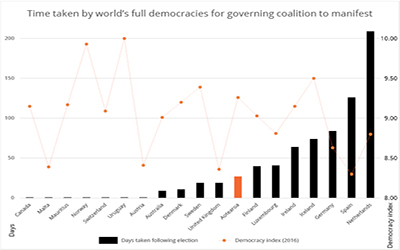
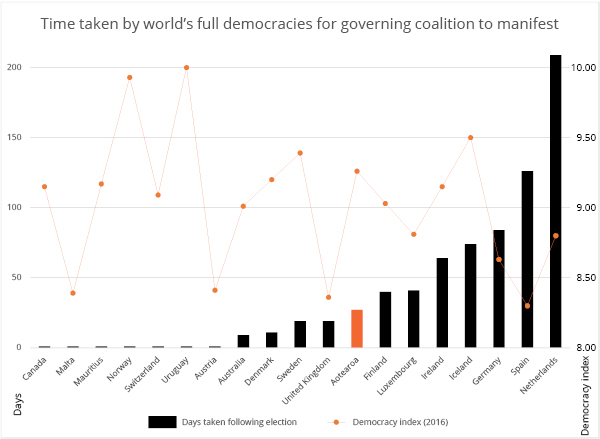
Democracy Delayed Democracy Denied: The Netherlands will be extremely lucky to retain its 2016 Economist democracy index rating of 8.8, out of 10, after this year’s abysmal, 208-day delay in manifesting a governing coalition. By democratising coalition preferences, Aotearoa could lead the world, and swell the ranks of the full democracies that respect their voters sufficiently to reveal the coalition outcome immediately votes are counted. chart Mahurangi Magazine
Half voted for change, and half for the status quo.
The 44.4% who voted for the New Zealand National Party, and the 0.5% who voted for what remains of ex-Labour-finance-minister Roger Douglas’ rebel act party, are now represented by 57 opposition members of Parliament, arraigned against 63 coalition members.
Winston Peters would have New Zealanders believe that voters had placed him in an invidious position. He claims has done the only thing he could, by choosing between a modified status quo and change, by choosing between a National-led and Labour-led government, each with a wafer-thin majority.
Given the ambiguous election result, the more obvious choice for the two major parties was grand coalition, for which there is ample precedent in countries accustomed to proportional representation. Indeed, even two-party polities have resorted to grand-coalitionincluding Aotearoa, during First World War and during the Great Depression, when putting national survival ahead of politics. Peters, of course, cannot be blamed for Labour and National obliging him to play kingmaker, by failing to even allude to the alternative, which has prevailed in Germany for the past 12 years. Peters appears to not have had the vision, or alternatively the courage, to broker a grander, grand coalition: a super-coalition.
Super-coalition is one option that would have handed Peters the top position, and allowed the 94.9% of voters for above-the-threshold parties to be constructively represented. While all those pleading for change, including the Mahurangi Magazine, are now, relative to there being a National-led government, in clover, the Trump–Republican rout and dismantling of every progressive win by President Barack Obama, is testimony as to how short-lived partisan gains can be.
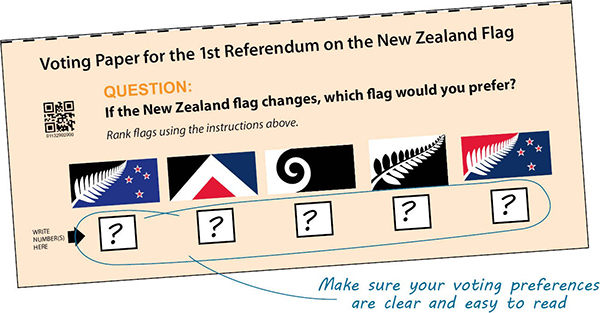
Important Enough for the Vanity Project: John Key’s uncalled-for $21.8 million fern-front flag project was considered of sufficient importance for preference voting to be used, but his government shamelessly stymied the work of the mmp review commission, albeit insufficiently diligent to include a recommendation to deploy preference voting to eliminate wasted party votes—121 413 wasted in this year’s election. image Electoral Commission New Zealand
Given super-coalition was spurned, all now relies upon Jacinda Ardern convincing the populace that she will indeed be prime minister for all New Zealanders. For example, rather than hogging the chairmanship of 15 of 17 select committees, as in the 51st New Zealand Parliament, it would behove Labour to entrust some of those roles to the half-dozen nationally respected opposition members, which includes Amy Adamsshe of the largest—nearly 20 thousand—majority and Chris Finlayson. Ardern is already showing far superior coalition-building skills than her role-model Helen Clark, by refusing to side-line the Green Party, but her government embarks against a stiff coalition-of-losers headwind that will take every ounce of her helming skills to overcome.
The tragedy, for which Labour and National share equal responsibility, is that New Zealand’s best-yet opportunity to take the super-coalition route has just been squandered, and many New Zealanders will go to their graves adhering to the coalition-of-losers narrative. Certainly, Winston Peters will go down in history as having done more to discredit the mixed-member-proportional system that any other politician of the period, not least of all by siding with National against those who had every reasonable expectation that the 2012 mmp Review would be acted upon. Labour itself was slow to embrace mixed-member proportional, but could now redeem itself by quickly enacting the entirely timid reforms recommended by the review, which National promised when it was confident that New Zealanders, if given the opportunity, would first vote for first-past-the-post, or one of its unworthy surrogates.
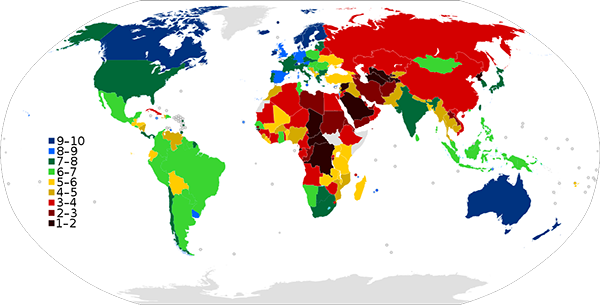
Not-So Blue Planet: With fewer than 10% of the world’s 195 countries indexed as full democracies, by a lenient measure that includes those in the thrall of big business, the ability to put the planet and meaningful climate action ahead of profits is severely compromised. image Economist Intelligence Unit | adapted by Mahurangi Magazine
As it transpired, the Opportunities Party, on 2.4%, was unlikely to have attracted sufficient support even had fewer potential voters been discouraged, by the 1-percentage-point-lower threshold recommended by the review. This, of course, is where preference voting so elegantly resolves the wasted-vote attribute of New Zealand’s out-of-step threshold. And, although the less-than-astute review commissioners failed to grasp the need for it, there is every reason for Jacinda Ardern to put her stamp on the reforms by introducing preference voting. Had preference voting been deployed in this election, 121 413 more people would be represented in Parliament, and, even without New Zealand First’s support, the below-the-threshold votes, rather than being wasted would likely have put Green–Labour three seats ahead of act–Nationalbecause the ACT of the ACT New Zealand party is an acronym, it should arguably be rendered as such .
Had a National-led government emerged, it was likely that rules would swiftly have been introduced to oblige the governor-general to first consider a coalition led by the party gaining the greatest number of seats. There is nothing remotely democratic about the premise that the single largest party should form the government. If, as it is indicated she will, Jacinda Ardern treats her coalition partners fairly, it is entirely possible that, in 2020, the Greens will rebound substantially, to say 15%, that New Zealand First might manage 9%, and that Labour and National will be on about 38% apiece. If Labour was to retain its 2017 37%, through sharing the coalition love, and National was on 39%, it would be an utter waste of Governor-General Dame Patsy Reddy’s, and everybody else’s, time for Paula Bennett, or whomever replaces Bill English, to be required to traipse to Government House with zero prospect of presenting a viable government. But that is not to say that it is remotely acceptable for there to be any doubt as to which parties will form the government, on the night of the election.
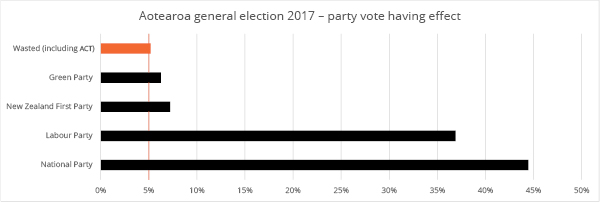
Waste Not Want Not: Prime Minister-designate Jacinda Ardern will want to be considerably kinder to her coalition friends than her Helen-Clark role model was, or introduce preference party-vote voting, or lower the threshold to 4%, or all three, if she is not to so totally eclipse the Greens and New Zealand First that she finds herself in Bill English’s current plight, in three years’ time. The act party’s 0.5% is included in the six-seats-worth of wasted votes here because its leader was directly elected to represent Epsom, thus gaming National’s representation—albeit only to the tune of 0.3%. Given that anthropogenic global warming is the existential issue of the millennia, and that successive Labour- and National-led governments have undertaken no meaningful climate action to date, lives literally depend on this government-of-change changing that, this parliamentary term. chart Mahurangi Magazine
The first imperative for a robust democracy is participation—democracy is a use-it-or-lose-it skill. As Donald Trump has so ineloquently demonstrated, when a demagogue emerges it is too late to mobilise to prevent the most-unpopular-polling-ever presidential candidate who wasn’t overtly a Ku Klux Klan leader from appropriating the most powerful role on the planet. In the hard-won battle to convince, especially young, people to vote, the last thing needed is the unedifying spectacle of the leaders of major parties prostrating themselves to a minor demagogue for a period almost a quarter as long as the official election campaign. That a below-average-percentage of people7.2%, compared to the average of 7.63% since 1993, and only a little over half its heyday, 1996 13.35% voted for New Zealand First in 2017, likely reflects the disquiet felt by those who agreed that they had indeed had enough after nine years of National-led government, but couldn’t trust Winston Peters to not do-a-1996, and prop up National for another three-year term, after campaigning against it.

Zero-Carbon Busways: Aucklanders old enough to recall their city’s trolleybus era with its excruciating delays when the poles of the otherwise smoothly operating rigs occasionally lost contact with their overhead wires when negotiating tight intersections or double-parked cars, can rest assured that their modern counterparts can run for tens of kilometres on battery power alone. Just as trolleybus supporter James Shaw takes up the reins as Minister for Climate Change, Greater Wellington Regional Council begins ripping down long-neglected trolleybus catenary infrastructure, and goes forward to the past with second-hand diesel buses. Shaw surely understands that the wholesale uptake of electric cars might reduce carbon and other pollution, but it will not reduce congestion—nor are electric cars half as eco-friendly as might be imagined. image Linz ag Linien
Beyond the indisputable need to eliminate the entirely unnecessary wastage of votes, and to abolish the consistently gamed coattails provision, there are other refinements that are overdue for attention. By excruciatingly topical example, it was entirely foreseeable the arbitrary delay in revealing the special-vote results, would, in a close election, complicate coalition building. While it is arguable that coalition negotiations, nevertheless, should have commenced immediately after the election, addressing the failure to progressively count both ordinary and special votes during the advanced voting period is a trivial matter to legislate for. The longer-term reform that this election’s unedifying bidding match reinforced the need for is democratisation of coalition conformation. Voters are being asked to trust to the party they support that that party will enter a coalition that will not cause them to regret their party-vote choice—such as had a Green–National government been the 2017 election outcome. To address this viciously undemocratic deficiency will require Aotearoa to be more than a mere follower, because no other country has had the courage to democratise coalition configuration. As the world’s first full democracy, Aotearoa should not suddenly feel apologetic or self-conscious about addressing what Europe has failed to. The reform should be introduced in three stages. Firstly, the voters of just electorate, say Wellington Central, would have the option of or indicating, along with their party vote, which coalition option they required their party-of-choice to pursue. For example, a National party-voter might be permitted to rank these options:
- Coalition with all parties (super coalition)
- Coalition with Green Party
- Coalition with Labour (grand coalition)
- Coalition with New Zealand First
- Coalition with none (govern alone or oppose government)
The options presented by a party would only be those which the parties involved approved in advance, except in the case of super coalition, which might, in time, be made mandatory. After trialling in one electorate, a nation-wide trial could be carried out at the following election. Finally, in nine years’ time, and providing that the sky hadn’t fallen, coalition preference voting would become binding, but would remain optional and additional to the current party-vote.
Given that only 19 of the world’s countries are considered full democracies, Aotearoa should strive to be the most comprehensive exemplar, and to export expertise and resources to the 176 most in need, not least of all the flawed democracy that is the United States.
After 2017’s all-too-close-run race for change, democratise coalitions now!
